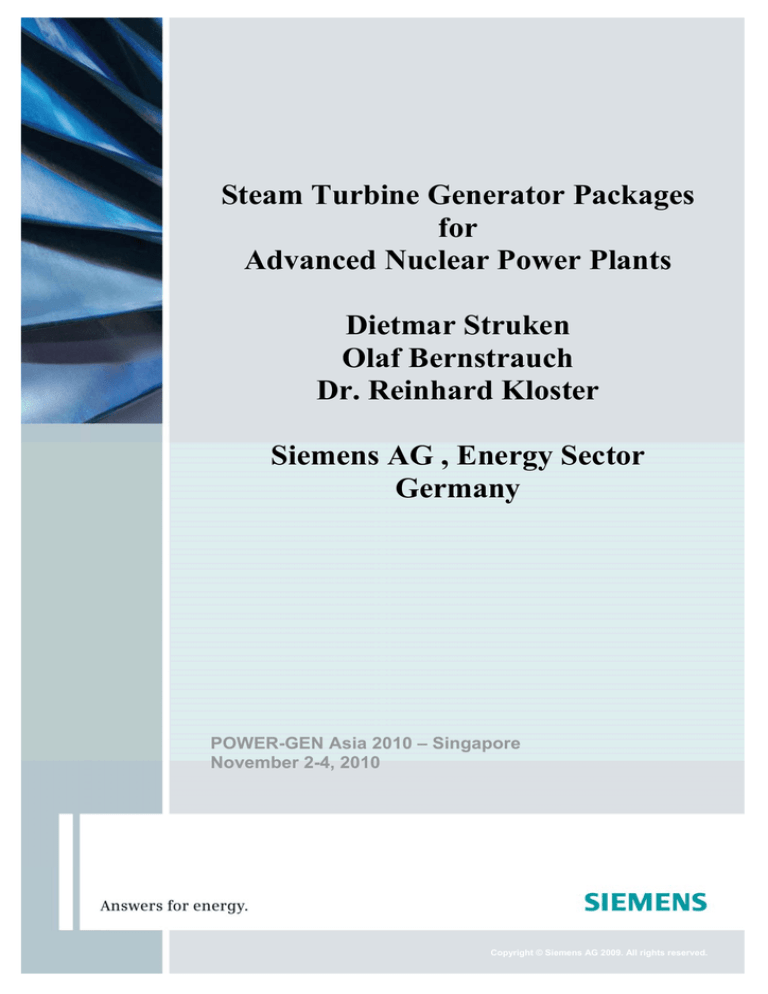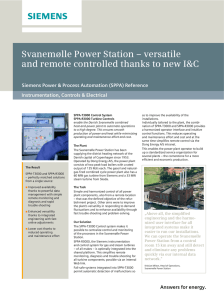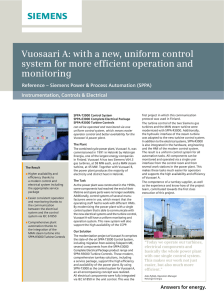
Steam Turbine Generator Packages
for
Advanced Nuclear Power Plants
Dietmar Struken
Olaf Bernstrauch
Dr. Reinhard Kloster
Siemens AG , Energy Sector
Germany
POWER-GEN Asia 2010 – Singapore
November 2-4, 2010
1
Copyright © Siemens AG 2009. All rights reserved.
Copyright © Siemens AG 2009. All rights reserved.
Steam Turbine Generator Packages
for advanced Nuclear Power Plants
Despite the current economic crisis and the increasing share of renewable energy, the long
term perspective predicts an increasing global demand for nuclear and fossil fired power
generation applications. [1]
In response to the growing demand of new nuclear power plants, Siemens is implementing
and further developing a modular platform of half speed steam turbines and generators
covering the most relevant power range from 1000 MWe up to 1900 MWe.
The following product will be described in this paper:
Siemens Steam Turbine Generator Packages:
SST-9000 series for nuclear power plants; 1000…1900 MW
Copyright © Siemens AG 2009. All rights reserved.
2
Steam Turbine Packages for Advanced Nuclear Power Plants (NPP)
The idea of the modular steam turbine platform for nuclear power plants is to keep the steam
turbine modules identical for arrangements with vertical and horizontal Moisture Separator /
Reheaters (MSR).
The SST-9000 series platform concept supports Conventional Island (CI) applications as well
as the component business.
Due to a combination of H and L turbine modules of different sizes, all relevant site
conditions and nuclear island concepts with pressurized water reactors (PWR) and boiling
water reactors (BWR) in 50 or 60 Hz application will be covered (see figure 1).
The design of these steam turbo sets for new nuclear power plants is based on excellent
operational experiences with Siemens KONVOI saturated steam turbo sets together with
service and retrofit experience as well as on experience gained during the project execution of
the world largest steam turbo set in Olkiluoto 3.
Significant design features, e.g. blading for highest performance and shafts in shrunk on disk
design are applied and continuously demonstrate excellent operational behavior and resistance
against stress corrosion cracking.
The latest Siemens 4-pole, 1500 rpm turbo generator fleet offers application ranges from 1100
MVA to 2222 MVA. Besides being designed to have this high capability, the generator is also
designed to be very efficient and to exhibit very low mechanical vibration levels.
Figure 1: Siemens new SST-9000 steam turbine series (1000 MW…1900 MW)
Copyright © Siemens AG 2009. All rights reserved.
3
SST-9000 Series Performance
The modular steam turbine platform design provides the flexibility to cover various reactor
types and sizes from 1000 MWe up to 1900 MWe (2900 to 4600 MWth) as well as different
site and cooling water conditions. The turbo set is designed for main steam conditions of up to
80 bar and more than 300 °C
Siemens Steam turbines have exceeded guaranteed efficiency values in various major service
projects.
High efficiencies will be achieved by state of the art blade profiles, blade path and turbine
design inheriting especially the experience in blade and blade path design.
Siemens has delivered the world largest L turbine to Olkiluoto in Finland taking advantage of
the extreme cold cooling water conditions at this site.
This turbo set has been equipped with a 2200 MVA turbo generator which is probably the
largest one.
SST-9000 Series Reliability /Availability
Siemens steam turbo sets for nuclear power plants have been proven for decades and millions
of accumulated operating hours [2].
Siemens steam turbo sets for nuclear power plants have proofed highest reliabilities and
availabilities (according to Areva Electricity Production World Championship 1980-2006 see
figure 2).
With our modular platform concept we will maintain and even improve the reliability and
availability of steam turbines for nuclear power plants.
The standardized modules are based on proven design features such as shrunk-on-disc-rotors
(in the L section) against stress corrosion cracking.
The new modular platform design even considers measures against a wide range of hazardous
incidents e.g. a high pressure shock on the main steam piping and turbine as a result of a
malfunction (late shut off) of one control valve.
Copyright © Siemens AG 2009. All rights reserved.
4
Figure2:
Siemens turbo sets in nuclear power plants and ranking in world electricity generation (source Areva NP)
=1. rank respectively highest electricity production per year
SST-9000 Series Construction / Service / Maintenance
Short installation- and outage times are being achieved due to modularity, automation and
optimized processes.
The turbo set and its parts are designed to be service friendly.
Copyright © Siemens AG 2009. All rights reserved.
5
Machine house concepts
Siemens has a good long time experience with a vertical MSR (Moisture Separator Reheater)
arrangement (see figure 3).
We recognize that - more and more - this arrangement concept will be considered for new
nuclear power plants.
Nevertheless the SST-9000 series even support a horizontal MSR arrangement.
(i.e. for Yang Jiang CPR projects in China)
In case of a horizontal MSR arrangement the crossover pipe routing will vary.
Figure 3: SST-9000 turbo set with vertical MSR arrangement concept
The overall length of the turbine including the generator for the shown setup is about 68 m.
Copyright © Siemens AG 2009. All rights reserved.
6
SST-9000 Design Features
The modular platform focus is on half speed design to cover the main market > 1000 MW.
Remark: the full speed design reaches its economical limit at about 1100 MW.
The half speed design is characterized by double bearing arrangement and well proven
shrunk-on-disk rotor with high resistance against stress corrosion cracking (see figure 4).
Figure 4: SST-9000 Design features:
double shell and double flow design; double bearing concept; shrunk-on-disk rotor
The turbo set consists of a double shell, double flow H turbine for main steam conditions of
up to 80 bar and more than 300 °C.
After the moisture separation and reheating (MSR) the steam enters two or three double shell,
double flow L turbine cylinders.
The half speed design with lower centrifugal forces compared to full speed allows the use of
highly alloyed chromium steel for the blades.
Siemens introduced a completely 3D-shaped blading for the overall expansion path.
The blade design relies on the 3DS (3D Secondary losses reduced) and 3DV (3D Variable
reaction) principle.
In addition, the L turbines are designed with an optimized blade path and diffuser setup taking
into account flow interaction to minimize the exhaust losses.
Measurements against corrosion and erosion are applied by advanced high chromium
materials, surface coatings and removal of water by suction slots in blades and drains in all
extraction lines.
In order to fulfill customer requests regarding seismic requirements, a very robust turbo set
arrangement with turbine table mounted hot reheat pipes has been designed.
Copyright © Siemens AG 2009. All rights reserved.
7
SST-9000 High Pressure Turbine (H)
The H turbine is of double-flow, double shell design with horizontally split outer and inner
casings (see figure 5).
High efficiency of the H turbine is assured by an optimum number of turbine stages and small
radial clearances between stationary and rotating blades.
No remarkable thrust changes during operation are the result of the double flow design with
symmetrically arranged stages and nozzles.
High flexibility during transient operation and short start-up times are the result of small
flanges due to the relatively low pressure in the outer casing.
Operational advantages of the rigid mono block H rotor in comparison to flexible rotors are
relatively small clearances, no instabilities due to resonance zones during start-up, no power
limitation on account of steam whirls and no self-exited oil film vibration can occur.
Three modules of H turbines cover the entire range of present nuclear reactor designs with a
power output from 2900 to 4600 MWth.
Figure 5: SST-9000 H turbine
Copyright © Siemens AG 2009. All rights reserved.
8
SST-9000 Low Pressure Turbine (L)
The L turbine casings are welded structures of horizontally split double flow and double shell
design.
The L rotor is a shrunk-on disk design especially suited for high power output and big rotor
sizes. It has a high safety level against stress corrosion cracking gained by design features,
material, quality, stress limitation and control of steam purity (see figure 6).
Millions of disk service hours have been accumulated without indication of stress corrosion
cracking. [3]
The Siemens L shrunk-on disk rotor design is the only design which copes the decisive three
factors to avoid stress corrosion cracking:
-
Steam/condensate impurities (electrical conductivity)
-
Material susceptibility to stress corrosion cracking (high yield strength)
-
High tensile stresses at the surface of the disks (stress concentration)
In addition to these design measures, special heat and surface treatment processes further
increase the resistance of disks to stress corrosion cracking:
-
Shot peening of certain areas of the disks
-
Rolling of shaft radii, L blade root radii, etc.
-
Water spraying after heat treatment
-
and others
Figure 6: SST-9000 Longitudinal section of L turbine
Copyright © Siemens AG 2009. All rights reserved.
9
The total last stage exhaust area can reach a maximum value of 180 m². This will be achieved
by a last stage blade with 1830 mm profile length (see figure 7).
Figure 7: SST-9000 Shrunk-on disk L rotor
Copyright © Siemens AG 2009. All rights reserved.
10
Generator
Siemens is one of the leading suppliers of power generators for power plant applications and
can provide generators with outputs of up to app. 2200 MVA.
The SGen-4000W 2200 MVA turbo generator 4-pole design is fundamentally based on the
1500-1700 MVA Siemens “Konvoi” turbo generators that have operated with high reliability
and availability for decades in nuclear power plants. To meet requirements specified for the
generator application in NPP with EPR reactors, well proven features from other 4-pole and
2-pole Siemens generators have been incorporated (see figure 8).
The generator is equipped with an all water cooled stator winding while the rotor winding is
directly hydrogen-cooled. The stator winding features a 27 kV insulation system.
The lead box holds water –cooled main leads.
The generator will be equipped with a brushless exciter (to be attached to the exciter end).
Results from the type test of this turbo generator in August 2008 showed excellent agreement
between design and tested values of the generator parameters. All results met or exceeded
requirements set by Siemens and by IEC standards.
Figure 8: SGen5-4000W (Type 2 Generators for Nuclear Applications)
Copyright © Siemens AG 2009. All rights reserved.
11
Customer benefits
- Highest reliability and availability of steam turbine packages proven by top places in
worldwide ranking lists for many years
- Certified manufacturing quality and experienced project management
- Low life cycle costs due to state-of- the art efficiency
- Service friendliness coupled with many years of experience as product- and solution
provider
- Short installation- and outage times due to modularity, automation and optimized processes
References of Siemens half speed steam turbines for nuclear power plants:
NPP Stade
NPP Biblis A, B
NPP Brunsbüttel
NPP Philippsburg
NPP Unterweser
NPP Isar 1, 2
NPP Krümmel
NPP Grand Gulf I, II
NPP Comanche Peak I, II
NPP Grafenrheinfeld
NPP Grohnde
NPP Gundremmingen B, C
NPP Brockdorf
NPP Emsland
NPP Neckarwestheim II
NPP Angra 2, 3
NPP Atucha II
NPP Olkiluoto 3
(under construction)
NPP Yang Jiang 1-6 (under construction)
Copyright © Siemens AG 2009. All rights reserved.
12
References:
1. Source: Siemens Energy Sector, GS4 base case
2. Zörner, W.:
Sattdampfturbosätze im Konvoi für Kernkraftwerke mit Druckwasserreaktoren.
Siemens-Energietechnik 4, Heft 3, 1982
3. Wichtmann, A.:
World largest 1715 MW Steam Turbine for Finland’s Olkiluoto 3 Nuclear Power Plant
Proceedings of the PowerGen 2004 conference, Barcelona 2004
4. Wichtmann, A. , Ulbrich A., Ulm, W., Schindler, N.:
Advanced nuclear steam turbines for best efficiency and highest power output
Siemens AG, 2007
Copyright © Siemens AG 2009. All rights reserved.
13
Permission for use
The content of this paper is copyrighted by Siemens and is licensed to PennWell for
publication and distribution only. Any inquiries regarding permission to use the content of
this paper, in whole or in part, for any purpose must be addressed to Siemens directly.
Disclaimer
These documents contain forward-looking statements and information – that is, statements
related to future, not past, events. These statements may be identified either orally or in
writing by words as “expects”, “anticipates”, “intends”, “plans”, “believes”, “seeks”,
“estimates”, “will” or words of similar meaning. Such statements are based on our current
expectations and certain assumptions, and are, therefore, subject to certain risks and
uncertainties. A variety of factors, many of which are beyond Siemens’ control, affect its
operations, performance, business strategy and results and could cause the actual results,
performance or achievements of Siemens worldwide to be materially different from any
future results, performance or achievements that may be expressed or implied by such
forward-looking statements. For us, particular uncertainties arise, among others, from changes
in general economic and business conditions, changes in currency exchange rates and interest
rates, introduction of competing products or technologies by other companies, lack of
acceptance of new products or services by customers targeted by Siemens worldwide, changes
in business strategy and various other factors. More detailed information about certain of
these factors is contained in Siemens’ filings with the SEC, which are available on the
Siemens website, www.siemens.com and on the SEC’s website, www.sec.gov. Should one or
more of these risks or uncertainties materialize, or should underlying assumptions prove
incorrect, actual results may vary materially from those described in the relevant forwardlooking statement as anticipated, believed, estimated, expected, intended, planned or
projected. Siemens does not intend or assume any obligation to update or revise these
forward-looking statements in light of developments which differ from those anticipated.
Trademarks mentioned in these documents are the property of Siemens AG, its affiliates or
their respective owners.
Copyright © Siemens AG 2009. All rights reserved.
14




